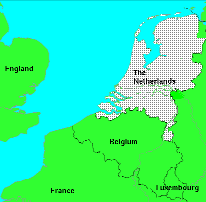
Location map for the Netherlands
1
Faculty of Archaeology,
Leiden University,
Reuvensplaats 4,
2311 BE Leiden,
The Netherlands.
tel. +31-(0)71-5272930,
fax +31-(0)71-5272429.
M.Wansleeben@rulpre.leidenuniv.nl
2
National Museum of Antiquities,
PoBox 11.114,
2301 EC Leiden,
The Netherlands.
Cite this as: Wansleeben, M. and Verhart, L.B.M. 1998 Graphical analysis of regional archaeological data: The use of site typology to explore the Dutch Neolithization process, Internet Archaeology 4. https://doi.org/10.11141/ia.4.5

Location map for the Netherlands
This electronic article has a structure adapted to the possibilities of this interactive medium. The issues and solutions that have governed our archaeological investigation in the south-east of the Netherlands will be discussed three times. You will have the opportunity to select in how much detail you want to follow our arguments. The three story lines, covering the same subject in parallel, are:
You may change levels at any time, using the hyperlinks less details and more details about. Within a level you may jump to the next or previous page with the Internet Archaeology toolbar at the top and bottom of each page. Another starting point is the Table of Contents.
Regional archaeological investigations may provide important information, supplementing excavation data. The research area of the Meuse Valley Project is archaeologically very rich. However, the wealth of surface sites sharply contrasts with the interpretational possibilities of these data. How to handle these strongly distorted regional data was methodologically the main challenge of the Meuse Valley Project. How should we adapt our data and analytical techniques, in order to obtain a meaningful insight into the course of the Neolithization process in an area at the very edge of the loess and the North-European plain. Which economic and social processes occur in that transition area, after the ever so crucial introduction of agriculture on the Central European loess area by the Bandkeramic communities.
Go to article Table of Contents
© Internet Archaeology
URL: http://intarch.ac.uk/journal/issue4/wansleeben_index.html
Last updated: Wed Jan 21 1998